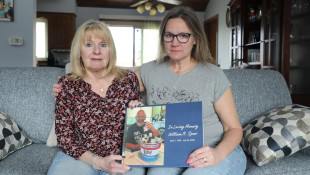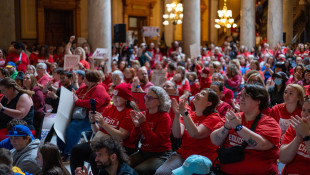
Amanda Oliver (left) and Gladys Tandy pose for a photo after a line dancing class in September. The two women have known each other for three years. They were connected through a hospital program for patients who are at risk for loneliness and social isolation.
Alex Li / Side Effects Public MediaIf you or someone you know is in crisis, please call, text or chat with the Suicide and Crisis Lifeline at 988, or contact the Crisis Text Line by texting TALK to 741741.
Gladys Tandy, 71, was in a vulnerable state after grappling with the weight of a breast cancer diagnosis and the responsibility of caring for her stroke-stricken brother and ultimately losing him. The stress and social isolation mandated by a global pandemic only made matters worse.
Tandy’s doctor recognized she was slipping into a sense of loneliness and depression. One remedy: a referral to a companion from the church who would check in on her over the phone.
That companion was Amanda Oliver, a volunteer.
“Since she's been in my life, we have just gotten so close, you will not believe the things that Amanda and I have in common,” Tandy said.
Recent surveys suggest that half of U.S. adults experience loneliness –– and the impact is not equal based on age and demographics. As more attention has been brought to the impact of loneliness and social isolation on people’s mental and physical health, some researchers, congregations and health organizations are taking steps to address it as part of preventative care.
Oliver, 69, has helped more than a dozen other patients like Tandy since she volunteered with the Congregational Care Network, a program at the regional hospital system, Indiana University Health.
The hospital program connects patients who are at risk of social isolation and loneliness with volunteers from various religious organizations including churches and mosques. The goal is to cultivate meaningful friendships, provide companionship, and facilitate access to community resources, such as transportation and food banks. Since the program’s launch in 2020, it has become part of the scope of health care services offered at the hospital for vulnerable patients
What started as companionship prescribed by the doctor blossomed into a friendship between Tandy and Oliver that’s been going on for more than three years now. One constant has been a weekly routine of line dancing classes.
“Line dancing has changed my life tremendously. I was going into a state of depression,” Tandy said.
Raymond Martin, their line dancing instructor, said making friends is not easy as one gets older.
“As we age, most of our friends pass away a lot of times before we're gone, and we're left without the friends we grew up with,” he said. “Here, you can come and make new friends almost immediately.”

Loneliness and isolation may be shaped by many factors, including culture, demographics, and social determinants of health such as the places where people live, work, learn, and play, according to the Centers for Disease Control and Prevention.
Young adults and the elderly are especially at risk.
Nearly two-thirds of individuals earning less than $50,000 and the majority of people on Medicaid, the government health insurance beneficiaries, report feeling lonely.
Racial minorities are also more at risk with 75% of Hispanic adults and 68% of African American adults saying they are lonely –– 10 points higher than the general population. Single parents are also particularly likely to struggle with loneliness, with more than two-thirds reporting loneliness.
The U.S. Surgeon General Dr. Vivek Murthy released an advisory in May declaring social isolation and loneliness a new public health epidemic in the country. He said loneliness is not just a bad feeling –– it harms both individual and societal health.
“Social isolation leads to more health, cardiovascular, sleep issues, anxiety, depression, diabetes, and stroke,” Belinda Watts, a primary care physician at IU Health, said.“If we can help those through trying to connect people and remove the isolation barrier, I think, the better off we are.”
Watts currently refers more than 60% of her patients to the companionship program at the hospital, which she believes completes the medical care of her patients.
What loneliness does to our mind and body
Loneliness is a subjective feeling. Mental health experts define it as feeling alone or disconnected due to a mismatch between the actual and desired level of social connection. This means that a person can have many friends but still feel lonely. Social isolation, on the other hand, refers to the lack of relationships with other humans and little to no social support. Both can harm the body and brain, and even if a socially-isolated person does not feel lonely, they could still be at risk for a host of physical ailments.
Studies in animals suggest that environmental monotony and social isolation can have a negative impact on the brain.
Scientists in Germany set out to study if the impact is similar in humans. They followed a group of nine people going on a 14-month antarctic expedition, where social interaction was limited. They obtained images of the expeditioners’ brains before and after the trip. They found that, compared to the control group, the expeditioners lost volume in parts of their brains that are responsible for decision-making and problem-solving. They also had reduced levels of a protein that helps develop and protect nerve cells. It’s hard to tell how much of that observed impact stems specifically from social isolation as opposed to other factors. The study also involved nine people only and researchers say “our data should be interpreted with caution”.
But other studies chronicle similar findings, which show that when people are lonely and lack social connection their bodies can go into a fight-or-flight mode. This raises the levels of cortisol, the stress hormone, which –– happening for a prolonged time –– could weaken the immune system, increase inflammation in the body, and affect heart health.
Researchers have studied loneliness and lack of social connection as a risk factor –– like they study diet and exercise, for example –– and found that lacking social connection can be as dangerous as smoking up to 15 cigarettes a day.
“This really does help us think about just how important we need to take our relationships for our health,” said Julianne Holt-Lunstad, the lead science editor of the surgeon general’s new advisory.
Congregations of all faiths can build a strong social infrastructure in local communities and play a role in nurturing these relationships, said Jay Foster, the vice president of Spiritual Care at Indiana University Health.
“This is what spiritual care, what chaplaincy does –– walk alongside and be a listening presence to people in the hospital, who are having, really, really terrible crises very often,” Foster said. “It's also what congregations of all faiths excel with, and that's to care for the sick and the shut-in.”

Currently, 26 congregations participate in the program, with 230 dedicated connectors like Amanda Oliver who are trained to support patients in local communities.
Over the past three years, more than 800 patients have enrolled in the program.
Shadreck Kamwendo, the Congregation Care Network manager at IU Health, said their community health engagement is helping the hospital learn more about the communities it serves.
“IU Health wants to make Indiana healthier. And that will happen if we engage our community well, understanding the struggles that are happening in our community,” Kamwendo said. “So what an opportunity for us, as we are here, to learn from our congregations, our neighbors, from the patients that we are taking care of. ”
The program initially started as a three-year pilot program funded by IU Health’s community impact investment fund. It has now been embedded in IU Health’s operational budget at its current level of service.
Dr. Murthy, the surgeon general, said individual relationships are a source of healing hiding in plain sight, which can help people live healthier, more productive, and fulfilled lives.
“Answer that phone call from a friend. Make time to share a meal. Listen without the distraction of your phone,” he said. “Perform an act of service. Express yourself authentically. The keys to human connection are simple but extraordinarily powerful.”
Contact reporter Alex Li at ali@wfyi.org.
Side Effects Public Media is a health reporting collaboration based at WFYI in Indianapolis. We partner with NPR stations across the Midwest and surrounding areas — including KBIA and KCUR in Missouri, Iowa Public Radio, Ideastream in Ohio and WFPL in Kentucky.
9(MDAyMzk1MzA4MDE2MjY3OTY1MjM5ZDJjYQ000))
 DONATE
DONATE





 View More Articles
View More Articles



 Support WFYI. We can't do it without you.
Support WFYI. We can't do it without you.